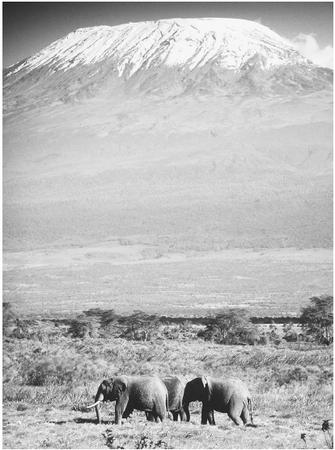Mountains - How it works
Plate Tectonics
Earth is constantly moving, driven by forces beneath its surface. The interior of Earth itself is divided into three major sections: the crust, mantle, and core. The lithosphere is the upper layer of Earth's interior, including the crust and the brittle portion at the top of the mantle. Tectonism is the deformation of the lithosphere, and the term tectonics refers to the study of this deformation. Most notable among examples of tectonic deformation is mountain building, or orogenesis, discussed later in this essay.
The planet's crust is not all of one piece: it is composed of numerous plates, which are steadily moving in relation to one another. This movement is responsible for all manner of phenomena, including earthquakes, volcanoes, and mountain building. All these ideas and many more are encompassed in the concept of plate tectonics, which is the name for a branch of geologic and geophysical study and of a dominant principle often described as "the unifying theory of geology" (see Plate Tectonics).
CONTENTS UNDER PRESSURE.
Tectonism results from the release and redistribution of energy from Earth's interior. This energy is either gravitational, and thus a function of the enormous mass at the planet's core, or thermal, resulting from the heat generated by radioactive decay. Differences in mass and heat within the planet's interior, known as pressure gradients, result in the deformation of rocks, placing many forms of stress and strain on them.
In scientific terms, stress is any attempt to deform an object, and strain is a change in dimension resulting from stress. Rocks experience stress in the form of tension, compression, and shear. Tension acts to stretch a material, whereas compression is a form of stress produced by the action of equal and opposite forces, whose effect is to reduce the length of a material. (Compression is a form of pressure.) Shear results from equal and opposite forces that do not act along the same plane. If a thick, hardbound book is lying flat, and one pushes the front cover from the side so that the covers and pages are no longer in alignment, is an example of shear.
Rocks manifest the strain resulting from these stresses by warping, sliding, or breaking. They may even flow, as though they were liquids, or melt and thus truly become liquid. As a result, Earth's interior may manifest faults, or fractures in rocks, as

Orogenesis
There are two basic types of tectonism: epeirogenesis and orogenesis. The first takes its namefrom the Greek words epeiros, meaning "mainland," and genesis, or "origin." Epeirogenesis, which takes the form of either uplift or subsidence, is a chiefly vertical form of movement and plays little role in either plate tectonics or mountain building.
Orogenesis, on the other hand, is mountain building, as the prefix oros ("mountain") shows. Orogenesis involves the formation of mountain ranges by means of folding, faulting, and volcanic activity—lateral movements as opposed to vertical ones. Geologists typically use the term orogenesis, instead of just "mountain building," when discussing the formation of large belts of mountains from tectonic processes.
PLATE MARGINS.
Plates may converge (move toward one another), diverge (move away from one another), or experience transform motion, meaning that they slide against one another. Convergence usually is associated with subduction, in which one plate is forced down into the mantle and eventually undergoes partial melting. This typically occurs in the ocean, creating a depression known as an oceanic trench.
There are three types of plate margins, or boundaries between plates, depending on the two types of crusts that interact: oceanic with oceanic, continental with continental, or continental with oceanic. Any of these margins may be involved in mountain formation. Orogenic belts, or mountain belts, typically are situated in subduction zones at convergent plate boundaries and consist of two types.
The first type occurs when igneous material (i.e., rock from volcanoes) forms on the upper plate of a subduction zone, causing the surface to rise. This can take place either in the oceanic crust, in which case the mountains formed are called island arcs, or along continental-oceanic margins. The Aleutian Islands are an example of an island arc, while the Andes range represent mountains formed by the subduction of an oceanic plate under a continental one.
The second type of mountain belt occurs when continental plates converge or collide. When continental plates converge, one plate may "try" to subduct the other, but ultimately the buoyancy of the lower plate (which floats, as it were, on the lithosphere) pushes it upward. The result is the creation of a wide, unusually thick or "tall" belt. An example is the Himalayas, the world's tallest mountain range, which is still being pushed upward as the result of a collision between India and Asia that happened some 30 million years ago. (See Plate Tectonics for more about continental drift and collisions between plates.)
Comment about this article, ask questions, or add new information about this topic: